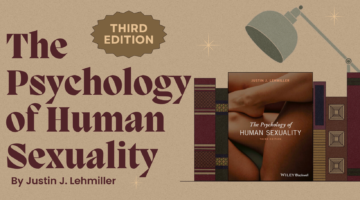8 Things Science Taught Us About Sex In 2021
December 30, 2021 by Justin Lehmiller
2021 has been memorable for a lot of reasons—including what science taught us about sex. Here’s a quick recap of some of the most interesting things we learned about sex this year, from how many people experience sex toy injuries each year to the types of sexual secrets people keep to the health benefits of orgasm.
1.) Most predictions about how the COVID-19 pandemic would impact sex didn’t pan out.
The popular media ran a ton of headlines about how the pandemic was going to change our sex lives. While they made for tantalizing reading at the time, it turns out they were mostly bunk! For example, many headlines talked about how everyone was going to be having more sex than ever, porn use would skyrocket, and that there would be a huge baby boom. Well, none of that come to pass. People ended up having less sex during the pandemic, and there are going to be hundreds of thousands of fewer births this year. As for porn, research found a slight increase at the beginning of the pandemic, but only for a minority of users–and this increase was temporary. COVID-19 is undoubtedly changing our sex lives, just not necessarily in the ways that the popular media predicted.
2.) The link between depression and sex is complex.
The story of how depression and sex are connected is complicated. Depression is one of those things that can affect different people in very different ways. In addition to being linked to a lack of sexual activity and low libido, research has found that depression is also linked to increased sexual risk-taking. Most notably, this includes having more unprotected or condomless sex. In other words, depression can potentially increase and decrease sexual activity. The way that depression affects sex depends, to some extent, on whether people are taking medication for it (which can produce sexual side effects), but it also depends on people’s coping strategy–and, specifically, whether they are internalizers or externalizers. Learn more in this article.
3.) Gay men and lesbians are far more similar in their interest in casual sex than heterosexual men and women.
Years of research have pointed to a very large gender difference when it comes to interest in casual sex, with heterosexual men being far more likely to accept offers of casual sex than heterosexual women. But what happens when you look at gay men vs. lesbians instead? While gay men are significantly more likely to say they accepted their most recent offer of casual sex than lesbian women (71% vs. 54% in one study and 76% vs. 62% in a second study), the majority of both groups accepted. The gender gap is much smaller when you look at gay men and lesbians, in part, because both groups appear to perceive casual sex partners as highly capable of bringing them pleasure (by contrast, heterosexual women have a much lower anticipation of pleasure than heterosexual men). Learn more about this study here.
4.) Men and women keep different sexual secrets.
In a study of young adults who were asked about their sexual secrets, researchers found that more than one-third of them (36%) said they held at least one sex secret in their current or most recent romantic relationship. However, the nature of secrets kept varied across gender. For women, the most common things they hid from their partners were: 1) history of sexual victimization, 2) having emotionally cheated on a significant other, 3) interest in BDSM, 4) pornography use, and 5) enjoyment of sex toys. For men, the most common things they hid included: 1) pornography use, 2) having previously had a threesome, and 3) having emotionally cheated on a significant other. Men’s and women’s reasons for keeping sex secrets also differed, which you can learn more about in this article.
5.) Sex toy injuries send thousands of people to the emergency room every year.
Sex toys can be a great addition to your sex life, but it’s important to use your toys correctly—and to understand how to use them safely—in order to avoid risk of injury because some people wind up in emergency rooms every year due to misuse of toys. Drawing upon data from the National Electronic Injury Surveillance System, researchers estimate that 18,547 vibrator injuries and 6,468 dildo injuries occurred over the last two decades. On average, that translates to about 1,250 sex toys injuries per year; however, it’s important to note that rates of injuries increased over time, going from a few hundred per year around 2000 to a few thousand per year by 2019. The most common injury? Devices getting lodged in the rectum and becoming irretrievable. Check out this article for some sex toy safety tips.
6.) Exposure to sunlight can boost testosterone and sexual desire.
Scientists have found that exposure to UVB light under controlled conditions is linked to changes in hormones and sexual behavior in animals and humans alike. For example, in one study where people were asked to avoid sunlight for two days and then spend 25 minutes in the sun, researchers documented a rise in testosterone in men and women alike when comparing blood samples from pre- and post-sunlight exposure. Likewise, following UVB phototherapy treatment, people report an increase in feelings of passionate love. So if the sun makes you horny, you’re not alone! Check out this article to learn more about why sunlight might have this effect.
7.) Orgasms are a natural nasal decongestant.
In a fascinating experiment, researchers tested men’s and women’s nasal function at five different points in time: before sex, right after orgasm, 30 minutes after orgasm, one hour after orgasm, and three hours after orgasm. Data on nasal function was also obtained before and after the use of a nasal decongestant spray as a comparison condition. What they found was that nasal flow was worse prior to both orgasm and spray use, but it improved immediately after and remained better for up to an hour in both cases. However, after three hours, nasal functioning was still improved with the use of the spray, but it had returned to baseline in the orgasm condition. These findings suggest that orgasm is a potential nasal decongestant and that it appears to work just as well as nasal sprays, at least for up to an hour. So for those seeking temporary nasal relief, an orgasm just might help for a bit!
8.) 1 in 10 Americans say they’ve had an orgasm while exercising.
In a nationally representative US sex survey, Americans were asked whether they had ever experienced an orgasm during physical exercise, and it turned out that about 1 in 10 people (9%) say this has happened to them before. A wide range of physical activities were reported; however, the single most common one for men and women alike involved abdominal exercises. Biking, running, and jogging were also reported by several participants. Less commonly, people mentioned things like jumping jacks and riding a rocking horse. This is further evidence that orgasms sometimes occur outside the context of sexual activity, and that orgasms aren’t always the result of direct genital stimulation.
Want to learn more about Sex and Psychology? Click here for more from the blog or here to listen to the podcast. Follow Sex and Psychology on Facebook, Twitter (@JustinLehmiller), or Reddit to receive updates. You can also follow Dr. Lehmiller on YouTube and Instagram.
Image source: Photo by Toa Heftiba on Unsplash

Dr. Justin Lehmiller
Founder & Owner of Sex and PsychologyDr. Justin Lehmiller is a social psychologist and Research Fellow at The Kinsey Institute. He runs the Sex and Psychology blog and podcast and is author of the popular book Tell Me What You Want. Dr. Lehmiller is an award-winning educator, and a prolific researcher who has published more than 50 academic works.
Read full bio >


